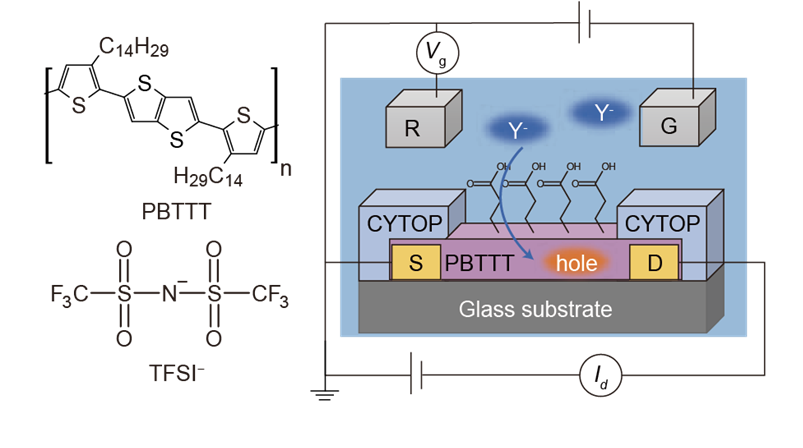Abstract
Electrolyte-gated organic transistors have gained increasing attention as electronic and bioelectronic components due to their ability to transduce ionic signals to electronic ones [1]. In polymer-based organic electrochemical transistors (OECTs), upon application of a gate voltage, electrolyte ions intercalate into the polymer channel and modulate the doping level, thereby significantly altering the channel conductance. This operating principle allows OECTs to exhibit high transconductance gain and sensitivity under low driving voltages, which make OECTs highly suitable for chemical and biological sensing, particularly for in situ signal amplification under physiological conditions.
To achieve highly sensitive operation, the use of subthreshold region is advantageous. Subthreshold swing (SS) is defined as the required voltage to change the current by one order of magnitude in the subthreshold region and serves as a critical parameter for evaluating the switching sharpness of a transistor. In OECTs, SS values typically in the range of 100-150 mV dec−1, far above the theoretical limit of 60 mV dec-1. To enable high-performance circuits and sensors, minimizing the SS is critical, as smaller SS values correspond to higher amplification capability and energy efficiency. Another persistent challenge lies in the operational stability of OECTs, particularly with respect to threshold voltage drift (Vth) under aqueous environments. OECT outputs tend to drift over time as the Vth gradually shifts, which can obscure the detection of target analytes in biosensors and necessitate frequent recalibration. Both chemical and physical adsorption at the semiconductor-electrolyte interface is known contributors to drift. Therefore, the design of thin-film and interface materials will be essential for achieving high operational stability without compromising device sensitivity.
In this study, we report the development of OECTs based on the semicrystalline polymeric semiconductor poly(2,5-bis(3-tetradecylthiophen-2-yl)thieno[3,2-b]thiophene) (PBTTT) doped with bis(trifluoromethanesulfonyl)imide (TFSI) anion (Fig. 1). The PBTTT thin film, characterized by its well-ordered lamellar structure and high crystallinity [2], enabled sharp subthreshold switching behavior approaching the thermodynamic limit of 60 mV dec−1 during OECT operation in aqueous electrolytes. To further enhance device stability and functionality, a fatty acid monolayer was introduced onto the OECT channel via the Langmuir-Blodgett (LB) method, with the hydrophilic headgroups oriented toward the aqueous phase. The resulting devices exhibit a remarkably low Vth drift of only 0.18 mV h−1 under continuous operation in aqueous environments, exceeding the long-term stability of most previously reported OECTs (Fig. 2). In addition to suppressing drift by stabilizing interfacial charge distributions, the monolayer imparts proton sensitivity. These findings highlight the potential of combining semicrystalline polymeric semiconductors with molecular-level interfacial engineering to develop OECT-based platforms for high-performance, low-power, and stable chemical sensing applications.



